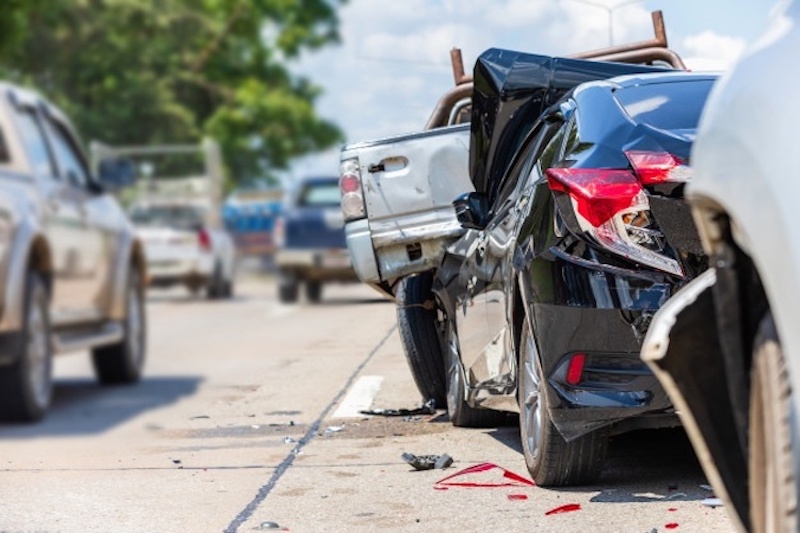
A Look at the Different Types of Vehicle Accidents

When you think of a car accident, you probably envision two vehicles tangled together. However, vehicle accidents can vary, as sometimes, only one car is involved.
Other collisions may involve multiple vehicles. Even the type of vehicle can vary since not all collisions involve only cars.
Today, we’re identifying common vehicle accident types so you’re in a better position to hopefully avoid being in a collision. Understanding the various types of vehicle accidents can also make it easier to file an insurance claim if you’re involved in a car wreck.
Types of Vehicle Accidents
The type of accident can play a role in the severity of your injuries and property damage. Here’s a look at some of the common types of vehicle accidents.
Sideswipe Accidents
When two vehicles are traveling beside each other in the same direction and one driver hits the side of the other vehicle, it’s known as a sideswipe accident. Several factors can cause one vehicle to swipe the side of another, but distracted driving is a common cause.
The inattentive driver glances away from the road for an instant and suddenly hits the side of your vehicle. If a driver forgets to check their blind spots, they can merge into another vehicle.
Rear-End Collisions
This type of accident occurs when one vehicle hits the back of the lead vehicle. Inattention and negligence are common causes of rear-end accidents.
If you’re wondering who’s liable for this type of accident, it’s usually the driver who crashed into the rear end of the other.
An exception can be if the lead driver is engaging in brake checking; this is when a lead driver suddenly applies their brakes for no reason. Brake checking is illegal and can shift the accident blame to the driver who applied their brakes.
Head-On Collisions
Head-on collisions tend to be serious accidents, often resulting in catastrophic injuries, since impact force is significantly increased.
This type of accident occurs when the front ends of two vehicles collide. Head-on collisions are also more likely to result in fatalities than some other types of accidents like a sideswipe.
Driver inattention, speeding, and fatigue are some of the common causes of head-on vehicle crashes. Unfortunately, DUI accidents can also involve a head-on collision. The intoxicated driver loses control of their vehicle, slamming head-on into an oncoming car.
T-Bone Accidents
Also known as side-impact collisions, T-bone accidents happen when the front of one vehicle makes contact with the side of another car. These accidents can cause significant injuries, especially on the side where the collision occurred.
So, what are some of the common reasons T-bone accidents happen? Texting and driving is a common cause.
A driver may run a red light while texting, slamming into the side of a vehicle with the right of way. If you’re the driver who T-bones another, you may be guilty of negligent behavior.
Single Vehicle Accidents
As the name implies, only one driver is involved in a single-car accident. The driver may fall asleep at the wheel and lose control of the vehicle.
Single-vehicle accidents can also be caused by someone else’s negligence. Debris left in the road by another vehicle can cause a driver to swerve resulting in the accident.
Sometimes, the road’s condition can lead to an accident. A large pothole can send a vehicle spinning out of control. Determining the cause of single-vehicle accidents can be a complex process, so it’s usually best to retain legal counsel.
Your attorney can investigate the accident and determine fault to help ensure you receive compensation for your damages if you’re eligible.
Multi-Vehicle Collisions
Multi-car accidents involve three or more vehicles and the resulting injuries tend to be catastrophic. Since more people are involved, this means multiple insurance companies. You may end up filing multiple claims to recover compensation for your damages.
Most multi-vehicle accidents stem from a chain reaction, so determining fault can be difficult. To help ensure you’re not assigned unnecessary blame for the accident, it’s a good idea to work with an attorney.
Your attorney can help you navigate the claim process while you focus on recovering from your injuries.
Injuries Common in Vehicle Accidents
Your injuries can vary from whiplash to minor contusions and even life-threatening internal injuries. The severity and type of crash often impact your injuries. Here’s a look at some of the common injuries sustained in auto accidents.
- Broken bones
- Burn injuries
- Injuries to the spinal cord
- Traumatic brain injuries (TBIs)
- Neck injuries
- Internal organ damage
- Facial injuries
Some vehicle accidents can even result in amputations. Fatalities are also a possibility, especially in more severe accidents like head-on and multi-vehicle collisions.
If a loved one is fatally injured in a car accident, you may be able to file a wrongful death claim against the at-fault driver/s.
A wrongful death claim can recover compensation for expenses like funeral and burial costs. The claim can also cover the deceased’s medical expenses and lost income. Your attorney can explain the steps necessary for filing and proving a wrongful death claim.
Damages You Can Recover After a Vehicle Accident
Every vehicle accident is different and this can affect your potential compensation. However, most personal injury claims list similar damages that can include:
- Lost wages
- Medical expenses
- Property damage
These are common economic damages, but you may also be entitled to receive compensation for your non-economic damages. These are intangible losses like pain, suffering, and emotional distress.
Since these damages don’t come with a convenient price tag, your attorney can use either the multiplier or per diem method to calculate their value.
Don’t File a Vehicle Accident Claim Alone
Going through the insurance claim process after a vehicle accident can be stressful, even if your injuries aren’t severe. You need to provide supporting documentation and sit through negotiations with the insurance company.
All of this can be overwhelming unless you have help. Your attorney can handle the process from start to finish and help ensure you receive compensation for your damages.


